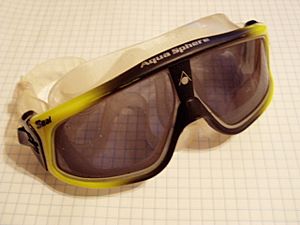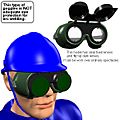Goggles facts for kids
Goggles and safety glasses are special glasses that protect your eyes. They are usually made of thick plastic. You might wear goggles for swimming to keep water out of your eyes. They are also super important for safety when you're working with tools or chemicals, or when small things could fly into your eyes. Even bright lights, like those from welding, need special goggles to protect your eyes.
Different Kinds of Goggles
Goggles are made differently depending on what you need them for. Here are some examples:
Cold Weather Goggles
These goggles are great for cold places. Most modern ones have two layers of lenses to stop them from getting foggy inside. If there was only one lens, your warm breath would make it foggy because the lens is cold. With two lenses, the inner one stays warmer, which helps stop fog. If water gets between the two layers, it can cause fog that's hard to remove, so good goggles are sealed tightly.
Swimming Goggles
Swimming goggles must keep water out of your eyes. This is important whether you're in salty ocean water or chlorinated pool water, as both can irritate your eyes. They also help you see clearly underwater. However, they can only be used a few feet deep. If you go deeper, the water pressure will push them too hard against your face. For deeper dives, you need a diving mask that lets you breathe air into it to balance the pressure. Some well-known swimming goggles are called Swedish goggles.
Goggles for Power Tools
When using power tools, goggles need to be very strong. They are usually made of polycarbonate, a material that won't break easily. This protects your eyes from pieces of metal, wood, plastic, or concrete that might fly off. They often have vents to stop sweat from building up and making the lenses foggy.
Blowtorch Goggles
These goggles protect your eyes from bright light, sparks, and hot metal when you are using or near a blowtorch. It's important to know that these are not the right kind of filters for arc welding, which needs even stronger protection.
Welding Goggles
Welding goggles protect your eyes during welding or cutting. They keep out flying bits and heat. With the right filters, they also protect your eyes from the bright light and radiation that welding creates. This radiation can cause a painful eye condition called arc eye.
Goggles for Outdoor Activities
When you're riding a motorcycle or doing other open-air activities, goggles stop insects, dust, and other small things from hitting your eyes.
Laboratory Goggles
In a lab or for research, goggles need to be strong enough to stop impacts. They also have side shields to protect your eyes from chemical splashes. Some lab goggles also offer special protection against lasers.
Racquetball Goggles
These goggles protect your eyes from racquetball racquets swinging in a small space and from the hard rubber ball hitting your face.
Winter Sports Goggles
For winter sports like skiing, goggles protect your eyes from bright glare and from icy bits flying up from the ground. The idea of double-lens anti-fog ski goggles was invented and patented by Robert Earl "Bob" Smith.
Astronomy and Meteorology Goggles
Dark adaptor goggles are used by people who study stars or weather. They wear these goggles before going outside at night to help their eyes get used to the dark more quickly.
Basketball Goggles
Some NBA players, like Kareem Abdul-Jabbar and Horace Grant, have worn goggles during games. They help prevent other players from accidentally scratching or hitting their eyes when trying to get the basketball. Often, a player starts wearing goggles to stop an eye injury from getting worse.
Aviation Goggles
In old biplanes and other open cockpit aircraft, pilots like Amelia Earhart wore goggles. These helped protect their eyes from the wind. Aviator goggles are still used today. An example is the AN-6530 goggles.
Virtual Reality Goggles
A virtual reality headset is sometimes called "goggles." These are worn over your eyes and show you computer images. They often make you feel like you are in a different, three-dimensional world.
Related pages
Images for kids
-
A U.S. Army Belgian Malinois dog wearing Doggles to protect his eyes from dust in Afghanistan
-
Traditional Inuit goggles made from caribou antler, used to fight snow blindness
See also
 In Spanish: Gafas protectoras para niños
In Spanish: Gafas protectoras para niños








